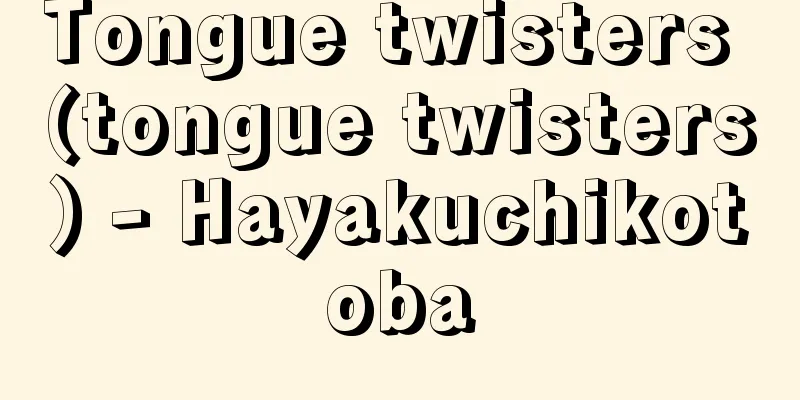Mathematics education

|
Humans cannot survive in modern society without some mathematical knowledge and ability. In order for this knowledge to develop and emerge in a useful way, deliberate external influence is necessary. In a broad sense, mathematics education refers to all man-made activities that aid this growth, and includes a wide range of things, including mathematics education at home, mathematics education at schools including universities, and mathematics education as social education provided by outside institutions for young people and adults. Here, we will mainly discuss mathematics education in schools such as elementary, junior high, and high schools. [Shimada Shigeru] Mathematics in school educationMathematics has always been respected as an important subject in modern school education. The main reasons for this can be summarized as follows: (1) Practical reasons: Learning mathematics is necessary and useful in daily and professional life. It helps us to deal with quantities, to solve problems using mathematical methods, and to make decisions. It is also useful as the language of science, in learning and promoting applications in sciences such as physics and in science and technology. (2) Cultural reasons. Getting to know the spirit (intellectual beauty) of mathematics as an important academic field created by humankind enhances one's culture and leads to the discovery of intellectual joy, just like appreciating music or paintings. (3) Training reasons: The study of mathematics fosters a wide range of logical thinking abilities. For example, mathematics is a highly abstract discipline, and the method of carefully building up theories one by one can be widely applied to the humanities, such as philosophy and logic. (4) Reasons for developing individuality: To stimulate and develop curiosity and the spirit of inquiry. To cultivate creativity. To draw out and develop mathematical potential. [Shimada Shigeru] History of Mathematics EducationTwo Origins of Mathematics EducationFrom an emergent perspective, mathematics has been created as something indispensable for human life. For example, mathematical documents from ancient Babylonia before the Common Era show that mathematics was gradually systematized as knowledge needed to secure food, clothing, and shelter. However, it was the ancient Greeks who did not simply accumulate knowledge about quantities but systematized it logically. Euclid's Stoicheia (Elemental Geometry, c. 300 BC) is a representative example of this, and has been considered a typical book not only of mathematics but also of science to later generations. The ideals of mathematics education must also be considered to have originated from these two sources. One is the position that mathematics should be studied as a useful tool for daily life, and the other is the position that theoretical structures and logical thinking methods should be learned through mathematics. Since secondary education was originally aimed at training leaders for society, the latter position was emphasized, and certain parts of Euclid's Elements were left almost unchanged and were considered the most important textbook in secondary education until the end of the 19th century. The ideals of mathematics education seen here were what is known as formal cultivation. However, with the progress of science and technology, not only the Greek view of mathematics but also the more simple view of mathematics seen in ancient Egypt and Babylonia came to be seen as necessary as the ideal of mathematics education in secondary schools. In other words, the position of teaching mathematics as a useful tool for everyday life and even for research in natural sciences came to be emphasized. This is mathematics education based on the idea of cultivating substance. In fact, the ideas behind the reform of mathematics education started by John Perry in the UK in the early 20th century could be said to have been the elevation of the idea of practical cultivation in secondary mathematics. Perry's arguments were supported by leading mathematicians of the time, such as Francis Klein of Germany and Eliakin Hastings Moore (1862-1932) of the US, and became a global movement for reforming education. Today's mathematics education can be seen as having been fundamentally influenced by this movement. [Kazue Hirabayashi] Modern Mathematics EducationMathematics Education Modernization MovementIn the 1960s, another worldwide reform movement in mathematics education began. It is called the Mathematics Education Modernization Movement, and there seem to be two reasons that started it. The first is the rapid progress of science and technology, especially computers. The artificial satellite Sputnik launched by the Soviet Union (at the time) in 1957 was a stunning symbol of this progress, and some even trace the beginning of the modernization movement to the launch of Sputnik. At the very least, it is fair to say that the work of SMSG (School Mathematics Study Group), which started in the United States and has since gained many followers around the world, on writing modern school mathematics textbooks, began with Sputnik. The second reason for the promotion of the modernization movement is thought to be the change in the view of mathematics itself that occurred in the 1930s. That is, from this time onwards, mathematics was no longer a servant of natural science, but began to rapidly develop as a completely independent academic field. In particular, the view of mathematics held by a group of young French mathematicians who shared the pen name Nicolas Bourbaki from 1939 onwards was the one that most clearly asserted the autonomy of modern mathematics. This can be summarized by the phrase "Mathematics is the study of 'structure'", but at least up until now, this is a phrase that has not been commonly heard in school mathematics, and it can be said that school mathematics has become detached from modern mathematics for that reason. The modernization movement aimed to reflect this modern view of mathematics to some extent in school education. This is also why "sets" began to appear in elementary school in Japan. In fact, "sets" are considered to be the place where "structures", the subject of research in modern mathematics, are installed. However, some people today say that the modernization movement has failed. And "set" has disappeared from Japanese elementary schools, at least as a term in the curriculum guidelines. The reason for this may be that the concepts of modern mathematics are sometimes difficult to understand for the general public, including teachers themselves. For example, the concept of "structure" itself is a difficult concept to explain in a way that is easy for the general public to understand, even though it is very common knowledge for mathematicians. [Kazue Hirabayashi] Remaining issuesThe content of mathematics education is also not as simple as commonly thought. For example, even at the level of today's junior high schools, it cannot be simply divided into numbers, quantities, shapes, etc. Some say that the content of mathematics education is "relationships," while others say it is "structure." Either way, it can be said that the way you perceive mathematics will change depending on how you perceive it. On the other hand, I think that the content of mathematics education can be viewed from both objective and subjective perspectives. Objectively, mathematics is the accumulation of mathematical propositions by humanity, and mathematics education can be considered as the study of these. However, there is also a position that believes that what truly deserves the name of mathematics is not the objective content itself, but the subjective mental activity of the human being who created it. From this perspective, mathematics education is about having students learn mathematical thinking through vicarious experience. In fact, the educational value of mathematics content in today's Japanese junior high school and above (or, depending on how you look at it, from the fifth grade of elementary school and above) cannot be recognized simply from its everyday usefulness. Also, considering that the number of people who use mathematics in science and technology is actually very small, the necessity of mathematics in general education cannot be asserted from the objective standpoint mentioned above alone. In order to accept the fact that mathematics is compulsory for all students up to the first year of high school, as it is today, one would have to take the subjective standpoint mentioned above and expect a widespread transfer of mathematical thinking. The reason why it was said that the focus of mathematics education in the 1980s was on "problem solving" was because it was thought to be the area in which mathematical thinking could be learned most organically. Even today, this thinking has not changed. However, this perspective on mathematics education cannot be fully reflected in practice in a country like Japan, where the examination system is strong. True problem solving is a series of organic processes including setting hypotheses, carrying out reasoning, proving, verifying, etc., and is considered to be a rather roundabout way of learning compared to the methods used to solve examination questions, which only require a quick answer. Furthermore, teaching methods for solving problems are complex, unlike simple drills, and there is still much to be studied in terms of teaching methodology. [Kazue Hirabayashi] Mathematics Education in JapanModern school education began in Japan in 1872 (Meiji 5), and since then, there have been many changes in what has been emphasized as ideas about what education should be have changed. Below we will take a look at this in detail by era. [Shimada Shigeru] Meiji PeriodThe first half of this period was a time of the introduction of Western mathematics education through translation. Thanks to the efforts of people in this era, new translations were created, new writing styles were devised, and mathematical symbols of foreign origin were incorporated into Japanese contexts, laying the foundation for later development. In terms of educational thinking, practical reasons were given first in elementary schools, to which training reasons were added. In secondary schools, there was a strong awareness of the cultural reasons of accepting Western learning, and the training reasons of cultivating logical ability. Of these, arithmetic, algebra (centered on equations), geometry (plane and solid geometry modeled after Euclid's "Elementar"), and trigonometry were taught as systematic studies, each with its own area and method. The main educational methods were teacher's explanations and examples, practice of imitating them, and memorization of important points. This trend continued until the Taisho and early Showa periods. From the middle of the Meiji period, the inconsistencies of the introduction period were gradually unified under the guidance of influential mathematicians, and the Japanese style of mathematics education was established. At that time in Japan, the disciplines of arithmetic, algebra, geometry, and trigonometry were treated independently, and theories were advanced through strict static logic. However, in the 20th century, Europe and America began to reflect on this. The content of algebra and geometry was also criticized as being quite detached from reality as a scientific language. It was argued that the practical aspects of the language of science should be emphasized, and that the concept of functions and calculus should be introduced early, while technical and peripheral content should be eliminated or reduced, the connections between subjects should be made closer, and activities that students can actively participate in, such as experiments, practical training, and work, should be introduced. [Shimada Shigeru] From the Taisho period until before World War IIDuring the Taisho period, this movement to reform mathematics education, which had begun abroad, was gradually introduced to Japan. This was also a time when secondary and higher education in Japan was expanding, and enthusiasm for continuing on to higher education was on the rise. As a result, entrance exams to higher education became tougher, and mathematics education aimed at exams began to have a strong influence. Those who set the exams tried to test high ability by using unconventional questions, and those taking the exams tried to deal with this by memorizing the new types of questions as if they were a certain type, creating a vicious cycle that increased the burden of study. Thus, the study of mathematics for the purpose of examinations, which was far removed from the original purpose of mathematics education, was promoted. Meanwhile, the development of psychology led to the denial of the unconditional assumption that mathematics learning has a disciplinary value, and provided an opportunity for those involved in mathematics education to reflect on their own efforts. These points led to a growing momentum among educators to improve mathematics education through their own efforts, and in 1919 (Taisho 8), the Japan Society of Mathematical Education for Secondary Education (the predecessor of the current Japan Society of Mathematical Education) was formed, and research and discussion on mathematics education became active around it. In elementary schools, attention began to be paid to practical arithmetic education that was linked to daily life, and mathematics education as a whole moved in the direction of reform as it entered the Showa period. From the end of the Taisho period to the end of World War II, the direction of reform that had begun to sprout during the Taisho period bore fruit in a uniquely Japanese form, and in arithmetic education, the idea of reform was realized in the form of national textbooks with green covers in 1935 (Showa 10). In secondary education, the movement to reform mathematics education mentioned above was reflected in the revision of the syllabus in 1933 (Showa 8). However, this revision was incomplete in some respects, and due to the pressure of entrance exam mathematics, it did not produce sufficient results. Dissatisfied with this, a movement calling for further improvement began around 1940 as the Mathematics Education Restructuring Movement, and in response to this, a major revision of the syllabus for secondary schools was carried out in 1942. This was the first time that the basics of calculus were introduced into secondary education, and in terms of liberal arts, there was a major shift from the idea of imparting a ready-made system to having students construct their own systems. Along with this, learning activities such as work and discussion were also widely incorporated, but as the war intensified, it was impossible to implement education in line with the spirit of the revision until the postwar period. [Shimada Shigeru] From the Second World War to todayBefore the Second World War, only the mathematics education in the old junior high schools was spoken of most enthusiastically. After the war, junior high school mathematics education, along with elementary school arithmetic education, was changed to a completely new type of mathematics education called "life unit study" by order of the Civilian Information and Education Department (CIE) of the General Headquarters for the Occupation Army, but the philosophy of mathematics in the new high schools escaped such a fundamental change, and the spirit of the revised teaching guidelines of 1942 (Showa 17) was barely preserved. In 1947, textbooks for "Analysis I", "Analysis II", "Geometry I", and "Geometry II" were created as national textbooks, and this format was maintained in the 1948 Course of Study (draft), except that unit study-type subjects were also included under the heading of "General Mathematics". The problem was the curriculum of the new junior high school. It was based on the spirit of life unit learning, just like elementary school, but how to connect the traditional mathematics content of the old junior high school to it was an extremely difficult problem. The textbook "Secondary School Mathematics" created by the Ministry of Education (now the Ministry of Education, Culture, Sports, Science and Technology) in 1947 shows the efforts to reconcile the two. The new junior high school was a completely new school in Japan. It was connected to elementary school as compulsory education and to high school as secondary education, but the educational philosophies of the two were historically independent. Mathematics, especially geometry, had a tradition as a subject unique to secondary education, and was not something that all children were required to study. The fact that it became a uniform requirement for all children after World War II posed a very serious problem. Problems in mathematics education that are still unresolved today, such as preventing dislike of mathematics and the feasibility of elite education, are probably fateful issues related to the nature of the new junior high school. In the 1958 revision of the curriculum guidelines, unit study was switched to systematic study and the focus became purely on mathematics, but the content was still somewhat optional, probably due to the dual nature of the new junior high schools. From around 1951, the Ministry of Education had been planning to revise only high school mathematics, leaving arithmetic and mathematics for elementary and junior high schools unchanged, and published the resulting curriculum guidelines in 1956. In this revision, the subjects were divided into "Mathematics I," "Mathematics IIA," "Mathematics IIB," and "Mathematics III," with "Applied Mathematics" added to the vocational curriculum. This division was not based on the traditional discipline-based divisions of "arithmetic," "analysis," and "geometry," but was closer to the division based on the spirit of integration of the Reformation Period. Another distinctive feature of this revised edition was that a central concept was indicated for each subject. Since then, the curriculum guidelines have been revised approximately every ten years. The mathematics curriculum guidelines for junior high and high schools, announced in 1969 and 1970, respectively, reflected the spirit of "modernization," which was the global trend in mathematics education at the time. The argument was that "current school mathematics is extremely outdated compared to modern mathematics, and the spirit of modern mathematics should be reflected more in school mathematics." Japan was greatly influenced by these reform movements in other countries, and the revision of the curriculum guidelines was one manifestation of this. This "modernization" program in Japan was not as radical as in developed countries, but there were calls for a course correction, and the content of both junior high and high schools was somewhat lightened in the 1977 and 1978 revisions, respectively. In particular, the high school progression rate reached 94% around this time, and talk of integrated elementary, junior high, and high school education began, so the selectivity of content had to be considered more seriously than ever before. The 1989 Course of Study gave greater consideration to measures to address differences in students' academic abilities, and while some of the content of junior high school mathematics was transferred to high school, it is noteworthy that the content at high school was further divided to make it easier to select. High school mathematics is divided into two series, "Mathematics I," "Mathematics II," and "Mathematics III," and "Mathematics A," "Mathematics B," and "Mathematics C," with the former being the main content and the latter being supplementary. Furthermore, only the three credits of "Mathematics I" became compulsory. Furthermore, the 1999 Course of Study further reduced the content for junior high school, and in addition to the two series mentioned above, a two-credit subject called "Basic Mathematics" was added, which could be made the only compulsory subject at high school. There are two driving forces behind the changes in mathematics in secondary education. One is entrance exams, and the other is a response to the diversification of students. The former weakens mathematical creativity, while the latter is prone to reducing content. History shows how difficult it is to simultaneously develop the human resources required for science and technology and provide everyone with the mathematical literacy they need. [Kazue Hirabayashi] "History of Mathematical Education" by Ogura Kinnosuke (1932, Iwanami Shoten)" ▽ "History of Modern Mathematical Education" by Ogura Kinnosuke and Nabeshima Shintaro (1957, Dainippon Tosho)" ▽ "Mathematics Courses for Junior and Senior High Schools: Approaches to the Modernization of Mathematical Education" edited by the Ministry of Education (1966, School Education Research Institute)" ▽ "Mathematical Education Around the World - Its New Trends" edited by the International Committee on Mathematical Education, translated by the Study Group for New Trends in Mathematical Education (1980, Kyoritsu Shuppan)" ▽ "The Failure of Modernizing Mathematical Education" by M. Klein, translated and supervised by Shibata Rokuji (1976, Reimei Shobo)" ▽ "Chronology of the History of Modern Mathematical Education" by Sasaki Gentaro (1985, Seibunsha)" ▽ "Studies in Mathematical Education" by Sasaki Gentaro (1986, Education Publishing Center)" ▽ "History of Secondary School Mathematical Education, Part 2" edited by the Japan Society for Mathematical Education (1986, Shinkyosha) [References] | | | | | | | | | | |Source: Shogakukan Encyclopedia Nipponica About Encyclopedia Nipponica Information | Legend |
|
人間は、なんらかの数学的な知識、能力なしには、現代の社会のなかでは生きていけない。それが役にたつような形に成長して表に出てくるためには、外からの意図的な働きかけが必要である。数学教育は、広義には、この成長を助ける人為的なあらゆる営みをさすもので、家庭における数学教育、大学を含めた学校における数学教育、青少年や成人を対象とした学校外の機関が行う社会教育としての数学教育などを幅広く含む。ここでは主として、小・中・高等学校等の学校教育における数学教育について述べる。 [島田 茂] 学校教育のなかの数学数学は、近代の学校教育のなかでは、つねに重要な教科として尊重されてきた。その理由のおもなものをまとめてみると、次のとおりである。 (1)実用的な理由 数学を学ぶことは、日常生活や職業生活を営むうえで必要かつ有用である。数量を扱ったり、数学の方法を用いて問題を解決したり、意志を決定したりするうえで役にたつ。また科学の言語として、物理学などの科学への応用や科学技術を習得し、推進するうえで役にたつ。 (2)教養的な理由 人類が生み出した重要な学問領域としての数学の精神(知的な美しさ)を知ることは、音楽や、絵画を鑑賞するのと同じく、教養を高め、知的喜びを知ることにつながる。 (3)訓練的な理由 数学の学習を通して、広く論理的な思考能力が養われる。たとえば、数学は高度に抽象的な学問であり、理論を一つ一つ緻密(ちみつ)に築き上げていくやり方は、哲学や論理学などの人文科学へも広く応用できる。 (4)個性伸長上の理由 好奇心、探究心を駆り立て伸ばす。創造性を培う。数学的な潜在能力を引き出し、伸ばす。 [島田 茂] 数学教育の歴史数学教育の二つの源流数学は発生的にみて、人間の生きていくうえに欠くことのできないものとしてつくられてきた。たとえば、紀元前の古代バビロニアの数学的文献からも、衣食住の確保のための知識として、数学が漸次体系化されてきたものであることがわかる。 ところが、単に数量に関する知識の集積というだけでなく、これを論理的に体系化したのは古代ギリシア人で、ユークリッドの『ストイケイア』(『幾何学原本』前300ころ)は、その代表的なものであり、後世まで数学書のみならず科学書の典型ともされた。 数学教育の理念も、まずこの二つの源流から由来していると考えなければならない。すなわち、一つは、日常生活に有用な道具として数学を学ばせようという立場と、いま一つは、理論的な構成や論理的な思考法を数学を通して学ばせようという立場である。そして、中等教育では、本来的に社会の指導者の養成を目ざしていたので、そこではむしろ後者の立場が重視され、ユークリッドの原論のある部分はほとんどそのままの形で、19世紀の末まで中等教育のもっとも重要な教科書とされてきた。ここにみられる数学教育の理念は、いわゆる形式陶冶(とうや)とよばれるものであった。 しかし、科学・技術の進歩とともに、ギリシア的数学観だけでなく、古代エジプト、バビロニアにもみられる、もっと素朴な数学観も、中等学校の数学教育の理念として必要なものと見直されるようになった。つまり、日常生活、さらには自然科学の研究に有用な道具として、数学を教えようとする立場が強調されるようになった。いわゆる実質陶冶の理念にたった数学教育である。 実際、20世紀初頭、イギリスのジョン・ペリーによっておこされた数学教育改造運動の理念は、中等数学における実質陶冶的理念の高揚であったということができる。ペリーの主張はドイツのF・クラインやアメリカのムーアEliakin Hastings Moore(1862―1932)など、当時の代表的数学者にも支持されて世界的な教育改造運動にもなり、今日の数学教育も、この運動から基本的な影響を受けているとみることができる。 [平林一栄] 現代の数学教育数学教育現代化運動1960年代になって、数学教育にはいま一つの世界的な改造運動がおこってきた。それは数学教育現代化運動とよばれるもので、その発端となった理由は二つあるように思われる。一つは、科学・技術、とりわけコンピュータの急速な進歩である。1957年のソ連(当時)の人工衛星スプートニクは、この進歩の衝撃的な象徴であり、現代化運動の発端をスプートニクの打上げに置く人さえある。少なくとも、アメリカに始まり世界的にも多くの追随者が得られたSMSG(学校数学研究グループSchool Mathematics Study Group)の学校数学の現代的な教科書著作活動は、その発端をスプートニクに置いているとみてよいであろう。 現代化運動を推進した第二の理由は、1930年代における数学観そのものの変化にあったともみられる。つまり、このころから数学はもはや自然科学の召使いでなく、完全に独自の学問分野として急速な発展を示すようになったからである。とくに1939年以来ニコラ・ブルバキNicolas Bourbakiという共通のペンネームをもったフランスの一群の若い数学者たちの数学観は、もっとも明確に現代数学の自律性を主張するものであった。 それは、「数学は『構造』の研究である」ということばによって要約できるだろうが、少なくとも、これまでの学校数学ではあまり聞き慣れなかったことばであり、それだけに学校数学は現代数学から離れてしまっていたともいえる。現代化運動は、このような現代的数学観をいくらかでも学校教育に反映させようというねらいをもっていた。日本で小学校から「集合」が登場するようになったのもそのためである。実際「集合」は、現代数学の研究対象である「構造」を据え付ける場所であると考えられている。 しかしながら、今日では、現代化運動は失敗だったという人もいる。そして「集合」は日本の小学校では、少なくとも学習指導要領での用語としては消えてしまった。その理由は、現代数学の理念が、ときには教師自身をも含めて、一般には理解されにくいものであったからでもあろう。たとえば「構造」という概念自体、数学者にはきわめて常識的なものであっても、一般に理解しやすいように解説することはむずかしい概念である。 [平林一栄] 残された課題数学教育の内容も、一般に考えられているほど単純ではない。たとえば、今日の中学校の水準でさえ、数・量・形などと単純に区分することはできない。ある人は数学教育の内容を「関係」であるといい、またある人は「構造」であるともいう。いずれにしても、数学をどうとらえるかによって、数学教育の内容のとらえ方も変わってくるといえよう。 一方、数学教育の内容は客観・主観の両面からとらえられるように思う。客観的には数学は人類の累積した数学的命題であり、それを学習させるのが数学教育であると考えられる。ところが、真に数学の名に値するものは、客観的内容そのものでなく、それをつくりだした人間の主観的精神活動であると考える立場もある。この立場からすれば、生徒に追体験として数学的考え方を学ばせることが数学教育であるということになる。 実際、今日の日本の中学校以上(考えようによれば小学5年以上)の数学内容の教育価値は、単なる日常的有用性だけからは認められない。また、科学・技術に数学を用いる人の数も実際にはきわめて少ないことからみても、前述の客観的立場だけから、普通教育における数学の必要性を主張することもできない。今日のように高校1年までは数学は全員必修になっている事実を是認するためには、前述の主観的立場にたって、数学的考え方の広範な転移を期待しなくてはならないであろう。1980年代の数学教育の焦点は「問題解決」にあるといわれたのも、それが数学的考え方をもっとも有機的に学習しうる領域であると考えられたからである。今日でも、この考え方には変化はない。 しかしながら、このような数学教育上の観点は、日本のような受験体制の強い国では十分に実践上に反映されえない。真の問題解決とは、仮設の設定、推理の実行、証明、検証などを含む一連の有機的な過程であり、早急に解答だけを求めればよい受験問題の解法からみれば、かなり迂遠(うえん)な手順の学習だとみなされるからである。また、問題解法の学習指導は単なるドリル指導とは違って複雑であり、教授方法学的にも研究されるべきところがまだ多く残されているといえよう。 [平林一栄] 日本の数学教育日本に近代的な学校教育が始まったのは1872年(明治5)のことであるが、それ以降、教育のあり方についての考え方の変遷に伴って、強調される点にもいろいろな変化があった。以下これを時代別に概観してみよう。 [島田 茂] 明治期この時代の前半は、欧米の数学教育の翻訳移入期であった。この時代の人たちの努力によって、これまでなかった訳語がつくられ、新しい文体が考案され、外国語を起源とする数学の記号系を日本語の文脈のなかに取り入れるくふうがなされるなどして、後の発展の基盤がつくられた。教育の考え方としては、小学校では、実用的な理由を第一にし、これに訓練的な理由が付加された形であった。中等学校では、欧米の学問を受け入れるという形での教養的な理由と、論理力を養うという訓練的な理由が強く意識され、このうちの第一の理由から、算術、代数(方程式を中心とした)、幾何(ユークリッドの『原本』に倣った形の平面・立体幾何)、三角法がそれぞれ独自の領域と方法をもつ体系的な学問として教えられた。教育の方法としては、教師の解説と示範、それを模倣する練習、重要事項の暗記などがおもなものであった。この傾向自体は大正、昭和初期まで続いた。 明治の中ほどからは、移入期の不統一な点が、有力な数学者たちの指導によってしだいに統一され、いちおう日本式の数学教育の形が決まってきた。このころのわが国では、算術、代数、幾何、三角法と分科をおいて、これを独立に扱う行き方や、厳格な静的な論理によって理論を進めるやり方がとられたが、20世紀に入るとヨーロッパやアメリカでは、これに対する反省がおこってきた。また代数や幾何の内容が、科学の言語としては現実からかなりかけ離れたものになっていることが批判されてきた。そして科学の言語としての実用的な面を重視し、関数概念、微積分を早期に導入するとともに、技巧的、末梢(まっしょう)的な内容を削除、軽減すること、科目間の関連を密にすること、実験、実習、作業など生徒が能動的に行う活動を取り入れることなどが主張されるようになった。 [島田 茂] 大正期より第二次世界大戦前まで大正期になって、外国で始まったこの数学教育改造運動は、日本に漸次紹介されていった。また、この時期は、日本の中等教育・高等教育が拡大された時期で、進学熱も高まり、それに伴って上級学校への入学試験も厳しくなり、試験を目的とした数学教育が大きな力をもつようになった。出題する側では、型にはまらない問題で高い能力をみようとし、受験する側では、これに対処しようとして新しい型の問題を一つの型として覚えようとし、悪循環となって学習負担を増した。 こうして数学教育の本来のねらいから外れた受験目的の学習が進められていった。一方、心理学の発達は、数学の学習について無条件に訓練的な価値を前提とすることを否定するようになり、数学教育に関係する人に反省の契機を与えた。これらの点から、教育界の人たちに自分たちの努力で数学教育を改善しようという機運が高まり、1919年(大正8)日本中等教育数学会(現在の日本数学教育学会の前身)が結成され、そこを中心として数学教育についての研究や論議が活発に行われるようになった。また小学校では、生活と結び付いた生きた算数教育が注目され始め、数学教育は全体として改革の方向に進みながら昭和期に移っていった。大正期の終わりから第二次世界大戦終了の時期までは、大正期に萌芽(ほうが)をみせていた改革の方向が日本独自の形で結実をみた時期で、算数教育にあっては1935年(昭和10)に緑表紙といわれる国定教科書となって改革の理念が実現した。 中等教育では、先に述べた数学教育改造運動が、1933年(昭和8)の教授要目改訂にいちおう反映された。しかし、この改訂は不徹底な面もあり、また受験数学の勢いにも押されて十分な成果をあげるには至らなかった。これを不満としていっそうの改善を求める動きが、数学教育再構成運動として1940年ころより始まり、これを受けて、1942年に中等学校の教授要目の大幅な改訂が行われた。ここで初めて微積分初歩を中等教育に取り入れるという内容的な面とともに、教養的な面においても、既成の体系を授けるという考えから、生徒に体系を組み立てさせるという方向に大転換した。これに伴い、作業や討議などの学習活動も大いに取り入れられることになったが、戦争の激化とともに、改訂の主旨に沿った教育を実施することは不可能なまま戦後を迎えた。 [島田 茂] 第二次世界大戦後より今日まで第二次世界大戦前は旧制中学校の数学教育だけがもっとも熱心に語られた。戦後の中学校数学教育は小学校の算数教育とともに、占領軍総司令部の民間情報教育部(CIE)の指令によって、「生活単元学習」というまったく新しい数学教育に切り替えられたが、新制高等学校の数学の理念は、このような根本的変革はまぬがれ、1942年(昭和17)の改訂教授要目の精神はかろうじて保たれた。そして1947年には国定教科書として「解析Ⅰ」「解析Ⅱ」「幾何Ⅰ」「幾何Ⅱ」の教科書がつくられたが、1948年の学習指導要領(試案)でもこの形式は保たれ、ただ「一般数学」として、単元学習的科目も置かれていた。 問題は新制中学校のカリキュラムであった。それは、小学校と同じく生活単元学習の精神に基づくものであったが、旧制中学校での伝統的な数学内容をそれにどうつなぐかは、きわめてむずかしい問題であった。1947年に文部省(現文部科学省)の作成した教科書「中等数学」には、この両者の折衷の苦心がみられる。新制中学校はわが国ではまったく新しい学校であった。それは義務教育としては小学校につながり、中等教育としては高等学校につながっているが、両者の教育理念は歴史発生的にみて独立したものであった。数学、とくに幾何は、中等教育に固有な教科としての伝統をもち、すべての子供に学習させるものではなかった。それが、第二次世界大戦後すべての子供に一様に課せられるようになったことは、きわめて重大な問題をはらんでいた。数学嫌いの防止、エリート教育の可否など、今日でもまだ未解決な数学教育の諸問題は、新制中学校の性格にまつわる宿命的なものであろう。1958年の学習指導要領の改訂では、単元学習は系統学習に切り替えられ、純粋に数学的内容が主になったが、それでも内容に一部選択性をとったのは、やはり新制中学校の二重性格によるものであったろう。 1951年(昭和26)ごろから、文部省は、小・中学校の算数・数学はそのままにして、高等学校数学だけの改訂を企てていたが、1956年にその学習指導要領を公布した。ここでは、科目の区分は「数学Ⅰ」「数学ⅡA」「数学ⅡB」「数学Ⅲ」となり、職業課程にはこのほかに「応用数学」がおかれた。この区分は、伝統的な「算術」「解析」「幾何」のような分科的な区分ではなく、改造期の融合の精神に基づく区分に近い。これとともに各科目に中心概念が示されたことも、この改訂版の特色であった。 これ以後ほぼ10年ごとに学習指導要領の改訂が行われる。それぞれ1969、1970年に告示された中学校、高等学校の学習指導要領数学編は、当時世界的な数学教育思潮となっていた「現代化」の精神を反映させたものであった。それは「現代の数学からみて今の学校数学はきわめて古くさく、もっと現代数学の精神を学校数学に反映させるべきだ」という主張であった。日本では、これらの諸外国の改革運動に多分に影響されたが、その一つの表れがこの学習指導要領の改訂であった。この「現代化」のプログラムは、日本では先進諸国に比してそれほど過激なものではなかったが、軌道修正の声もあって、それぞれ1977、1978年の改訂では、中学、高校ともに多少の内容の軽減が図られた。とくにこのころ高校の進学率は94%に達し、小・中・高一貫教育が語られるようになったため、内容の選択性もこれまで以上に真剣に考えられねばならなくなった。 1989年(平成1)の学習指導要領では、生徒の学力差に対応する処置がいっそう考慮され、中学校数学の内容が高校に移されることもあったが、高校での内容はさらに選択履修しやすく区分されたことが注目される。高校数学は「数学Ⅰ」「数学Ⅱ」「数学Ⅲ」と「数学A」「数学B」「数学C」の2系列からなり、前者は主要な内容、後者は補足的な内容となった。そして、「数学Ⅰ」の3単位だけが必修となった。さらに1999年の学習指導要領では中学校の内容はさらに軽減され、高校では前述の2系列のほかに「基礎数学」という2単位の科目が設けられ、これだけを必修にすることができるようになった。 中等教育の数学の変遷には、二つの動因がある。一つは受験であり、もう一つは生徒の多様化への対策である。前者は数学的創造性を弱め、後者は内容の軽減に陥りやすい。科学技術が要請する人材の育成と、すべての人に必要な数学的教養を与えることの両立のむずかしさを、これまでの歴史は示している。 [平林一栄] 『小倉金之助著『数学教育史』(1932・岩波書店)』▽『小倉金之助・鍋島信太郎著『現代数学教育史』(1957・大日本図書)』▽『文部省編『中学校高等学校数学講座 数学教育現代化へのアプローチ』(1966・学校教育研究所)』▽『数学教育国際委員会編、数学教育新動向研究会訳『世界の数学教育――その新しい動向』(1980・共立出版)』▽『M・クライン著、柴田録次監訳『数学教育現代化の失敗』(1976・黎明書房)』▽『佐々木元太郎著『現代数学教育史年表』(1985・聖文社)』▽『佐々木元太郎著『数学教育学の研究』(1986・教育出版センター)』▽『日本数学教育学会編『中等学校数学教育史上・下』(1986・新教社)』 [参照項目] | | | | | | | | | | |出典 小学館 日本大百科全書(ニッポニカ)日本大百科全書(ニッポニカ)について 情報 | 凡例 |
<<: Sogakuji Temple - Sugakuji
>>: Foundations of Mathematics
Recommend
Miboro Dam - Miboro Dam
This is Japan's first large-scale rock-fill d...
clouds
…Of course, Japanese kasuri, which developed rema...
Fruitlands
...The Transcendentalist social reform movement c...
rainbow lorikeet
...Nine species are found in the Lesser Sunda Isl...
sot
...Pioneer works include The Boy and the Blind Ma...
Common poorwill
...Because they feed on insects, all birds that b...
Ito style
A leading school of early modern spearmanship, th...
Sabines - Sabines (English spelling)
A group of Italians who lived in central Italy in...
General judicial police officer
A type of judicial police officer. A general polic...
Weber, W.
… [Developed country style pop music] Popular mus...
Pathology
...A field of study that studies higher-level men...
Elementary excitation
The excited state of a macroscopic object consisti...
Schmidt, H.
...The grand coalition government was dissolved d...
Kitora Tomb (Kametora Tomb) - Kitora Tomb
Abeyama, Asuka Village, Nara Prefecture, is a tumu...
Dannay, F.
...The pen name of the American mystery writers F...









